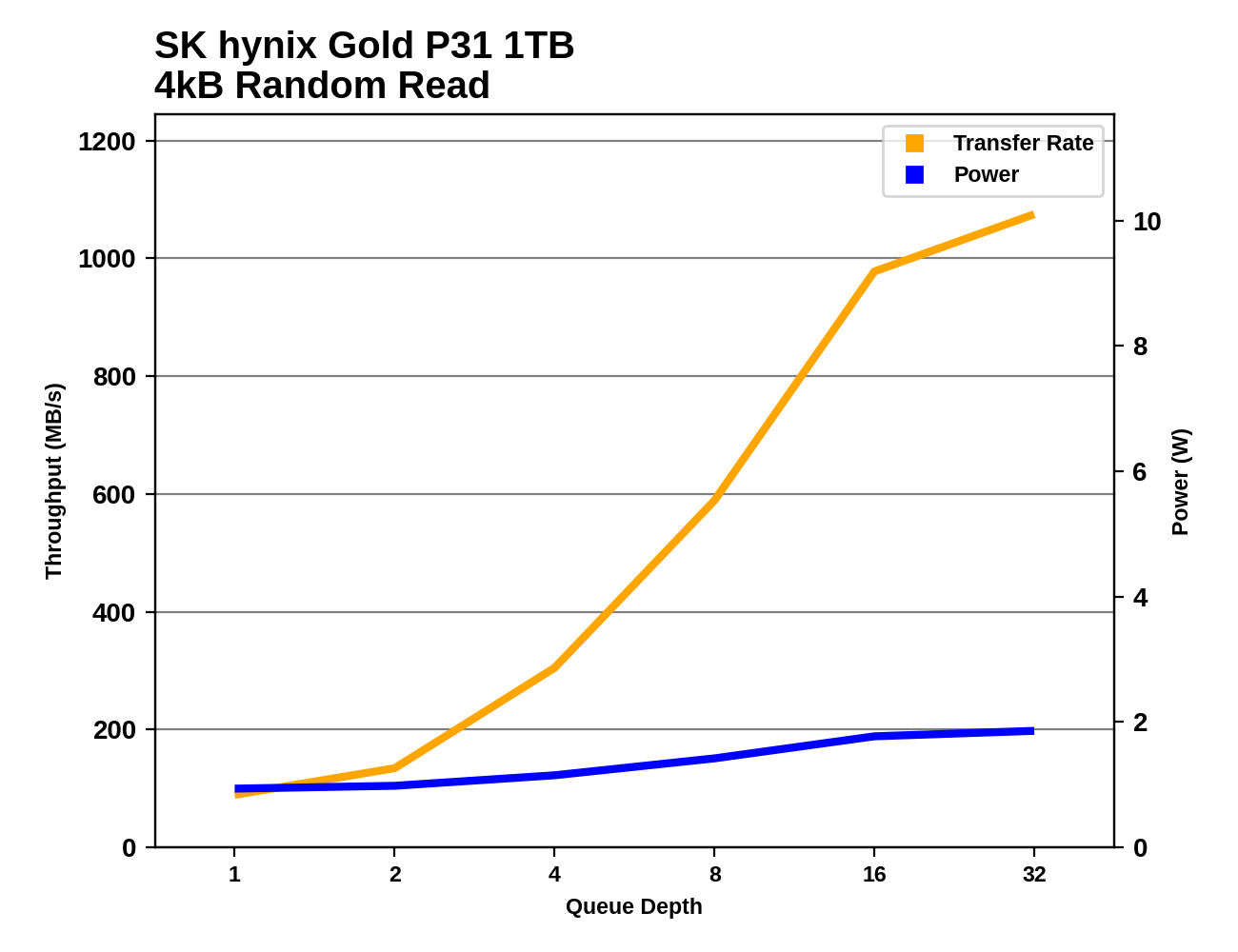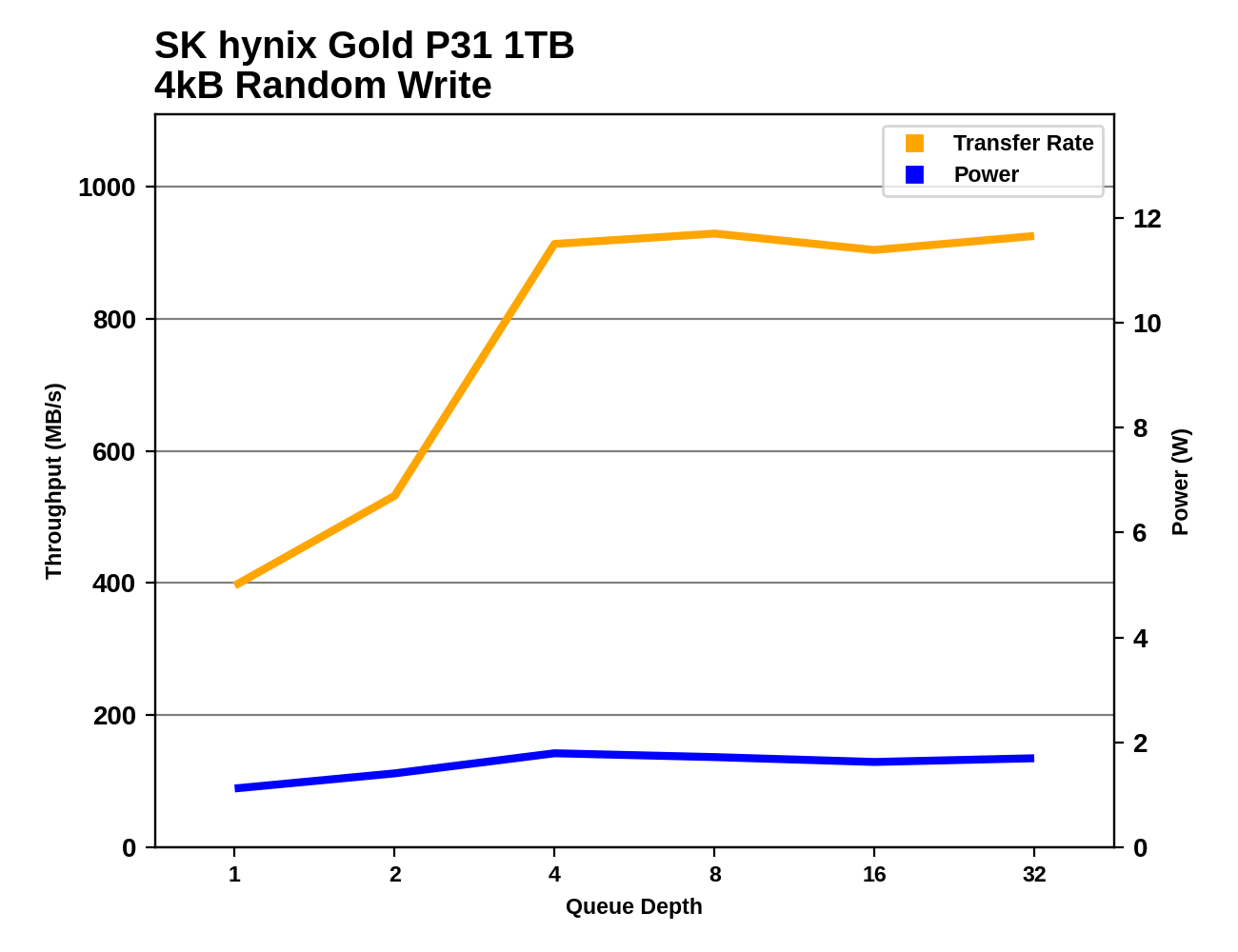The Best NVMe SSD for Laptops and Notebooks: SK hynix Gold P31 1TB SSD Reviewed
by Billy Tallis on August 27, 2020 8:00 AM ESTRandom Read Performance
Our first test of random read performance uses very short bursts of operations issued one at a time with no queuing. The drives are given enough idle time between bursts to yield an overall duty cycle of 20%, so thermal throttling is impossible. Each burst consists of a total of 32MB of 4kB random reads, from a 16GB span of the disk. The total data read is 1GB.

The QD1 burst random read performance of the SK hynix Gold P31 is similar to what we see from drives using the Silicon Motion SM2262EN controller, which has dominated this test since it hit the market.
Our sustained random read performance is similar to the random read test from our 2015 test suite: queue depths from 1 to 32 are tested, and the average performance and power efficiency across QD1, QD2 and QD4 are reported as the primary scores. Each queue depth is tested for one minute or 32GB of data transferred, whichever is shorter. After each queue depth is tested, the drive is given up to one minute to cool off so that the higher queue depths are unlikely to be affected by accumulated heat build-up. The individual read operations are again 4kB, and cover a 64GB span of the drive.

On the longer random read test that reaches into higher queue depths, the Gold P31 pulls narrowly ahead of the SX8200 Pro to set a new record for TLC-based SSDs.
 |
|||||||||
| Power Efficiency in MB/s/W | Average Power in W | ||||||||
The power draw of the Gold P31 is only a hair above that of its SATA sibling, the Gold S31. But the P31 is delivering almost three times the performance of that drive, and twice the performance per Watt of the next most efficient drive.
 |
|||||||||
The Gold P31 delivers class-leading performance across the entire range of queue depths covered by this test. Its performance is starting to taper off by QD32, but at that point it has caught up with the throughput of the Optane 905P. The widest margins over other TLC SSDs are around QD8 through QD16. Power consumption remains very low throughout the test, not even reaching 2W at QD32 - that 2x efficiency advantage over the competition remains just as true at high queue depths.
Plotting the P31's results against the entire benchmark database shows that the P31 stakes out new territory. The closest competition on the power/performance landscape are the tiny Intel Optane Memory M.2 drives, and at QD4 or higher all the other flash-based SSDs need considerably more power to deliver the same performance (at QD4 and below, the P31 is still in SATA performance territory where there are more low-power competitors).
Random Write Performance
Our test of random write burst performance is structured similarly to the random read burst test, but each burst is only 4MB and the total test length is 128MB. The 4kB random write operations are distributed over a 16GB span of the drive, and the operations are issued one at a time with no queuing.

The burst random write performance of the Gold P31 is lackluster: slower than most high-end NVMe drives, though actually still a bit faster than the Samsung 970 EVO Plus.
As with the sustained random read test, our sustained 4kB random write test runs for up to one minute or 32GB per queue depth, covering a 64GB span of the drive and giving the drive up to 1 minute of idle time between queue depths to allow for write caches to be flushed and for the drive to cool down.

On the longer random write test that includes some higher queue depths, the high-end NVMe drives mostly have fairly similar scores, and the P31 falls in the middle of the pack for performance.
 |
|||||||||
| Power Efficiency in MB/s/W | Average Power in W | ||||||||
Once again, the power consumption of the Gold P31 is more in line with low-power SATA or DRAMless NVMe drives, even though it offers high-end performance. This time, the efficiency score isn't quite twice that of the next best competitor, but a 75% improvement is still impressive.
 |
|||||||||
The performance profile for the Gold P31 on the random write test is fairly typical: fill performance is reached at QD4, and performance is mostly steady through the rest of the test. The P31 starts out slightly slower at QD1, but at full speed it is definitely competitive.
Comparing the Gold P31's random write performance against our entire database of results shows it standing out even more clearly than it did for the random read results. The QD1 random write performance is already beyond the reach of SATA drives, and none of the other NVMe drives we've tested operate at such low power levels.












80 Comments
View All Comments
MrCommunistGen - Thursday, August 27, 2020 - link
Truly impressive drive! I'm glad you were able to confirm that the power efficiency numbers held up and weren't the result of some kind of measurement error. When the Platinum P31 comes out I'll probably snag a 2TB model to upgrade my 1TB XG6 in my main ITX rig.Interesting that you mentioned the SN520. I needed a 2242 or 2230 SSD for a project I'm working on and was trying to decide between a BG4 and the SN520. I was able to refer to the previous Anandtech 1TB BG4 review but even then, I'm looking at either a 128GB or 256GB drive as that's what's available 2nd hand on eBay and the 1TB drive's performance isn't going to really represent the smaller drives.
On the other hand I've found exactly nothing on the SN520.
They're cheap enough so I decided to just buy one of each and test them both and see how they compare.
Luminar - Thursday, August 27, 2020 - link
The 2280 form factor SN500s/SN520s are more common than the 2242s and 2230s.I would buy a 2280 SN520 and just Dremel it down to a 2242 form factor. It's been proven to work. As Anandtech wrote in their review, the electronics are only in the first 30mm of the PCB.
MrCommunistGen - Thursday, August 27, 2020 - link
For the heck of it I decided to buy a bunch of different 2230 and 2242 SSDs on eBay to test. I was surprised to find 6 different models, 5 of which are from well-known brands. They all seem to be OEM drives pulled from laptops.I skipped any of the no-name, known garbage drives.
lilkwarrior - Thursday, August 27, 2020 - link
Why was the 970 plus in the benchmarks, but not the 970 Pro?MrCommunistGen - Thursday, August 27, 2020 - link
If you really want to compare the performance of the P31 and the 970 Pro, you can look up the results in the "Bench" section of the website:https://www.anandtech.com/bench/product/2627?vs=24...
To answer your question directly:
I'd imagine that's because for a lot of client workloads the performance of the 970 Pro is relatively similar to the 970 EVO Plus. The Pro definitely has lower latency, particularly write latency -- but again -- in most client workloads that isn't going to translate into very noticeable differences.
However, the Pro is SO much more expensive. Realistically, someone shopping for a fast consumer SSD who is looking at the P31 isn't going to also be considering the 970 Pro.
FWIW, at the 1TB capacity the 970 Pro seems to be selling for ~$320, the 970 EVO Plus for ~$190, and the P31 for $135.
If the idea is to compare to the highest performing non-volatile storage available today, that's probably what the Optane 905P results are for.
PaulHoule - Thursday, August 27, 2020 - link
It is as if Taiyo Yuden started making writable DVD's under its own name.nirolf - Friday, August 28, 2020 - link
Ha ha! Good one!jyotaro - Thursday, August 27, 2020 - link
Any plans for a 500gb review of this product?Billy Tallis - Thursday, August 27, 2020 - link
Not at the moment. I'll try to get them to cough up a sample of that one when the Platinum P31 is released so I can compare across the full range of capacities, but I don't know how likely it is that they'll agree. This is still a pretty new relationship between us and SK hynix PR.ozzuneoj86 - Thursday, August 27, 2020 - link
Maybe I missed it, but does the high efficiency of this drive translate to significantly less heat output? Seems like it should. Some kind of thermal test would be useful for choosing a mobile SSD especially.